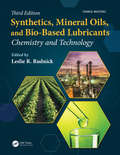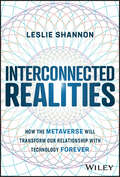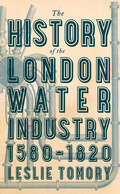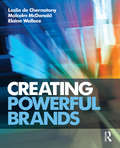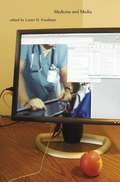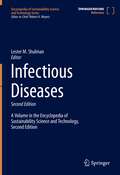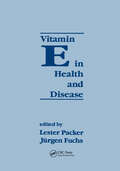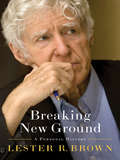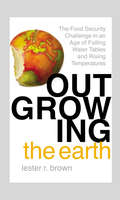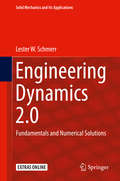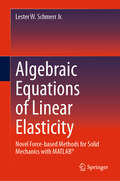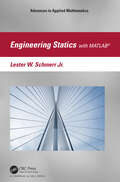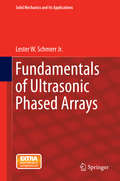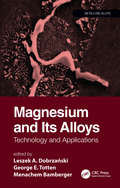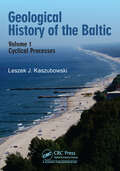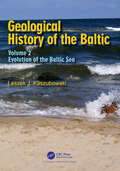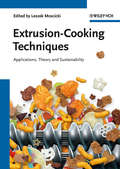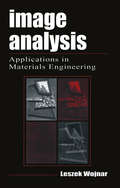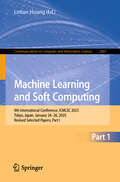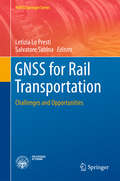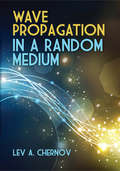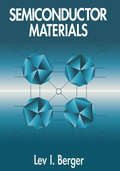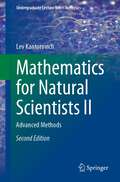- Table View
- List View
Synthetics, Mineral Oils, and Bio-Based Lubricants: Chemistry and Technology (Chemical Industries)
by Leslie R. RudnickHighlighting the major economic and industrial changes in the lubrication industry since the first edition, Synthetics, Mineral Oils, and Bio-Based Lubricants: Chemistry and Technology, Third Edition highlights the major economic and industrial changes in the lubrication industry and outlines the state of the art in each major lubricant application area. Chapters cover the use of lubricant fluids, growth or decline of market areas and applications, potential new applications, production capacities, and regulatory issues, including biodegradability, toxicity, and food production equipment lubrication. The highly-anticipated third edition features new and updated chapters including those on automatic and continuously variable transmission fluids, fluids for food-grade applications, oil-soluble polyalkylene glycols, functional bio-based lubricant base stocks, farnesene-derived polyolefins, estolides, bio-based lubricants from soybean oil, and trends in construction equipment lubrication. Features include: Contains an index of terms, acronyms, and analytical testing methods. Presents the latest conventions for describing upgraded mineral oil base fluids. Considers all the major lubrication areas: engine oils, industrial lubricants, food-grade applications, greases, and space-age applications Includes individual chapters on lubricant applications—such as environmentally friendly, disk drive, and magnetizable fluids—for major market areas around the globe. In a single, unique volume, Synthetics, Mineral Oils, and Bio-Based Lubricants: Chemistry and Technology, Third Edition offers property and performance information of fluids, theoretical and practical background to their current applications, and strong indicators for global market trends that will influence the industry for years to come.
Interconnected Realities: How the Metaverse Will Transform Our Relationship to Technology Forever
by Leslie ShannonExplore how the metaverse is changing our livesIn Interconnected Realities, Leslie Shannon, Head of Trend and Innovation Scouting at Nokia, delivers an energizing and optimistic new take on the Metaverse. Starting with metaverse realms already in existence today, the book explores the purpose that each independent platform serves, as well as how all these disparate realms will ultimately be stitched together to permanently transform our personal and business lives. A singularly insightful and informed exploration of a fascinating subject at the intersection of technology, business, and society, Interconnected Realities is an essential resource for executives, managers, board members, and other business leaders at companies in a wide range of industries, as well as tech enthusiasts, futurists, and anyone with an interest in the future of social interaction, business, or technology.
The History of the London Water Industry, 1580–1820
by Leslie TomoryHow did pre-industrial London build the biggest water supply industry on earth?Beginning in 1580, a number of competing London companies sold water directly to consumers through a large network of wooden mains in the expanding metropolis. This new water industry flourished throughout the 1600s, eventually expanding to serve tens of thousands of homes. By the late eighteenth century, more than 80 percent of the city’s houses had water connections—making London the best-served metropolis in the world while demonstrating that it was legally, commercially, and technologically possible to run an infrastructure network within the largest city on earth.In this richly detailed book, historian Leslie Tomory shows how new technologies imported from the Continent, including waterwheel-driven piston pumps, spurred the rapid growth of London’s water industry. The business was further sustained by an explosion in consumer demand, particularly in the city’s wealthy West End. Meanwhile, several key local innovations reshaped the industry by enlarging the size of the supply network. By 1800, the success of London’s water industry made it a model for other cities in Europe and beyond as they began to build their own water networks. The city’s water infrastructure even inspired builders of other large-scale urban projects, including gas and sewage supply networks.The History of the London Water Industry, 1580–1820 explores the technological, cultural, and mercantile factors that created and sustained this remarkable industry. Tomory examines how the joint-stock form became popular with water companies, providing a stable legal structure that allowed for expansion. He also explains how the roots of the London water industry’s divergence from the Continent and even from other British cities was rooted both in the size of London as a market and in the late seventeenth-century consumer revolution. This fascinating and unique study of essential utilities in the early modern period will interest business historians and historians of science and technology alike.
The History of the London Water Industry, 1580–1820
by Leslie TomoryThis in-depth study explores the technological, cultural, and mercantile factors behind the infrastructure that transformed early modern London.Beginning in 1580, a number of competing London companies sold water directly to consumers through a large network of wooden mains in the expanding metropolis. This new water industry flourished throughout the 1600s, eventually expanding to serve tens of thousands of homes. By the late eighteenth century, more than 80 percent of the city’s houses had water connections—making London the best-served metropolis in the world while demonstrating that it was legally, commercially, and technologically possible to run an infrastructure network within the largest city on earth.Historian Leslie Tomory shows how an explosion of consumer demand and new technologies imported from the Continent spurred the rapid growth of London’s water industry. Meanwhile, several key local innovations reshaped the industry by enlarging the size of the supply network. By 1800, the success of London’s water industry made it a model for cities across Europe and beyond. It even inspired builders of other large-scale urban projects, including gas and sewage supply networks.
Creating Powerful Brands: The Strategic Route To Success In Consumer, Industrial And Service Markets (Cim Professional Ser.)
by Leslie de ChernatonyThis has long been the one book that students can rely on to get them thinking critically and strategically about branding. This new fourth edition is no exception. THE definitive introductory textbook for this crucial topic, it is highly illustrated and comes packed with over 50 brand-new, real examples of influential marketing campaigns. Bullets:• Summarises the latest thinking and best practice in the domain of branding• All new real marketing campaigns show how branding theories are implemented in practice• Brought right up to date with a clear European and UK focusUndergraduate business and marketing students studying brand management will find this an invaluable resource in their quest to understand how branding really works.
Cultural Sutures: Medicine and Media
by Lester D. FriedmanMedicine and the media exist in a unique symbiosis. Increasingly, health-care consumers turn to media sources--from news reports to Web sites to tv shows--for information about diseases, treatments, pharmacology, and important health issues. And just as the media scour the medical terrain for news stories and plot lines, those in the health-care industry use the media to publicize legitimate stories and advance particular agendas. The essays in Cultural Sutures delineate this deeply collaborative process by scrutinizing a broad range of interconnections between medicine and the media in print journalism, advertisements, fiction films, television shows, documentaries, and computer technology. In this volume, scholars of cinema studies, philosophy, English, sociology, health-care education, women's studies, bioethics, and other fields demonstrate how the world of medicine engages and permeates the media that surround us. Whether examining the press coverage of the Jack Kevorkian-euthanasia controversy; pondering questions about accessibility, accountability, and professionalism raised by such films as Awakenings, The Doctor, and Lorenzo's Oil; analyzing the depiction of doctors, patients, and medicine on E. R. and Chicago Hope; or considering the ways in which digital technologies have redefined the medical body, these essays are consistently illuminating and provocative. Contributors. Arthur Caplan, Tod Chambers, Stephanie Clark-Brown, Marc R. Cohen, Kelly A. Cole, Lucy Fischer, Lester D. Friedman, Joy V. Fuqua, Sander L. Gilman, Norbert Goldfield, Joel Howell, Therese Jones, Timothy Lenoir, Gregory Makoul, Marilyn Chandler McEntyre, Faith McLellan, Jonathan M. Metzl, Christie Milliken, Martin F. Norden, Kirsten Ostherr, Limor Peer, Audrey Shafer, Joseph Turow, Greg VandeKieft, Otto F. Wahl
Infectious Diseases (Encyclopedia of Sustainability Science and Technology Series)
by Lester M. ShulmanThis volume on Infectious Diseases in an Encyclopedia of Sustainability Science and Technology (ESST) addresses the needs of health care providers and policy makers as well as scientists and engineers. Most of chapters in this volume deal with infectious diseases that directly affect humans, including the detailed characterization of specific pathogens, how they reproduce, how they are transmitted, and the means available to control, eliminate, or eradicate them. In this revised and updated second edition, the number of human infectious diseases covered has been significantly expanded. Other new chapters deal with current leading edge technologies for the diagnosis of pathogens; surveillance including environmental and syndromic surveillance for pathogens; requirements for quality assurance, quality control and the need for biological standards and controls to sustain high quality diagnosis and surveillance; the use of big data for personalized medicine; modeling infectious diseases; zoonotic and vector borne diseases; disease prevention with antibiotics, antivirals and vaccines; and factors that affect ecological balances leading to emergence of new diseases such as climate change and deforestation. Finally, infectious diseases that affect livestock and culture of plants for food, comfort and beauty are also addressed, since we must also consider them when discussing sustainability of humans in our ecosystem.
Vitamin E in Health and Disease: Biochemistry and Clinical Applications
by Lester PackerProbes developments and trends in research and clinical applications of vitamin E, discussing its chemistry and biochemistry and natural occurence in nuts, seeds, whole grains and vegetable and fish-liver oils. The book covers new findings on the role of vitamin E as a biological response modifier.
Breaking New Ground: A Personal History
by Lester R. BrownAn inspirational memoir tracing Lester Brown's life from a small-farm childhood to leadership as a global environmental activist. Lester R. Brown, whom the Washington Post praised as "one of the world's most influential thinkers," built his understanding of global environmental issues from the ground up. Brown spent his childhood working on the family's small farm. His entrepreneurial skills surfaced early. Even while excelling in school, he launched with his younger brother a tomato-growing operation that by 1958 was producing 1.5 million pounds of tomatoes. Later, at the U.S. Department of Agriculture, Brown emphasized the need for systemic thinking. In 1963 he did the first global food supply and demand projections to the end of the century. While on a brief assignment in India in 1965, he pieced together the clues that led him to sound the alarm on an impending famine there. His urgent warning to the U.S. and Indian governments set in motion the largest food rescue effort in history, helping to save millions of lives. This experience led India to adopt new agricultural practices, which he helped to shape. Brown went on to advise governments internationally and to found the Worldwatch and Earth Policy institutes, two major nonprofit environmental research organizations. Both brilliant and articulate, through his many books he has brought to the fore the interconnections among such issues as overpopulation, climate change, and water shortages and their effect on food security. His 1995 book, Who Will Feed China?, led to a broad restructuring of China's agricultural policy. Never one to focus only on the problem, Brown always proposes pragmatic, employable solutions to stave off the unfolding ecological crises that endanger our future.
Outgrowing the Earth: The Food Security Challenge in an Age of Falling Water Tables and Rising Temperatures
by Lester R. BrownHistorically, food security was the responsibility of ministries of agriculture but today that has changed: decisions made in ministries of energy may instead have the greatest effect on the food situation. Recent research reporting that a one degree Celsius rise in temperature can reduce grain yields by 10 per cent means that energy policy is now directly affecting crop production. Agriculture is a water-intensive activity and, while public attention has focused on oil depletion, it is aquifer depletion that poses the more serious threat. There are substitutes for oil, but none for water and the link between our fossil fuel addiction, climate change and food security is now clear. While population growth has slowed over the past three decades, we are still adding 76 million people per year. In a world where the historical rise in land productivity has slowed by half since 1990, eradicating hunger may depend as much on family planners as on farmers. The bottom line is that future food security depends not only on efforts within agriculture but also on energy policies that stabilize climate, a worldwide effort to raise water productivity, the evolution of land-efficient transport systems, and population policies that seek a humane balance between population and food. Outgrowing the Earth advances our thinking on food security issues that the world will be wrestling with for years to come.
The Bear Went Over the Mountain: Soviet Combat Tactics in Afghanistan
by Lester W. GrauAuthor has made an attempt to draw general conclusions about the little-investigated experiences in the training and the conduct of combat which were influenced by Afghanistan experience. These include specific mission decisions involving blocking and destroying guerrilla forces, etc.
Engineering Dynamics 2.0: Fundamentals and Numerical Solutions (Solid Mechanics and Its Applications #254)
by Lester W. SchmerrThis book presents a new approach to learning the dynamics of particles and rigid bodies at an intermediate to advanced level. There are three distinguishing features of this approach. First, the primary emphasis is to obtain the equations of motion of dynamical systems and to solve them numerically. As a consequence, most of the analytical exercises and homework found in traditional dynamics texts written at this level are replaced by MATLAB®-based simulations. Second, extensive use is made of matrices. Matrices are essential to define the important role that constraints have on the behavior of dynamical systems. Matrices are also key elements in many of the software tools that engineers use to solve more complex and practical dynamics problems, such as in the multi-body codes used for analyzing mechanical, aerospace, and biomechanics systems. The third and feature is the use of a combination of Newton-Euler and Lagrangian (analytical mechanics) treatments for solving dynamics problems. Rather than discussing these two treatments separately, Engineering Dynamics 2.0 uses a geometrical approach that ties these two treatments together, leading to a more transparent description of difficult concepts such as "virtual" displacements.Some important highlights of the book include: Extensive discussion of the role of constraints in formulating and solving dynamics problems.Implementation of a highly unified approach to dynamics in a simple context suitable for a second-level course.Descriptions of non-linear phenomena such as parametric resonances and chaotic behavior.A treatment of both dynamic and static stability.Overviews of the numerical methods (ordinary differential equation solvers, Newton-Raphson method) needed to solve dynamics problems.An introduction to the dynamics of deformable bodies and the use of finite difference and finite element methods.Engineering Dynamics 2.0 provides a unique, modern treatment of dynamics problems that is directly useful in advanced engineering applications. It is a valuable resource for undergraduate and graduate students and for practicing engineers.
Algebraic Equations of Linear Elasticity: Novel Force-based Methods for Solid Mechanics with MATLAB®
by Lester W. Schmerr Jr.This book describes a second-generation force-based method emerging from a general formulation where the partial differential equations of elasticity are replaced by equivalent algebraic equations. These algebraic equations of linear elasticity can be used to solve statically indeterminate problems in reduced forms that define either the new second-generation force-based approach or a new displacement-based approach. The new force-based method can serve as the basis for teaching students at many technical levels how to solve equilibrium problems directly for the forces present. In elasticity courses, the derivation and use of the algebraic equations of linear elasticity can show how the difficulties of dealing with partial differential equations may be avoided by transforming those equations into algebraic equations with work-energy concepts. In a finite element course, a force-based finite element method can be described along with the traditional displacement-based approach to demonstrate how the two methods provide alternative ways for solving complex structural problems. Serving as a resource for including second-generation force-based methods in solid mechanics courses of an engineering curriculum, and as a robust learning resource, the book is ideal for instructors and for students, practicing engineers, and researchers.
Engineering Statics with MATLAB® (ISSN)
by Lester W. Schmerr Jr.This text makes use of symbolic algebra and vector-matrix algebra to demonstrate a new approach to learning statics. Symbolic solutions are obtained, together with the types of solutions covered in other texts, so that students can see the advantages of this new approach.This innovative text is an extension of second-generation vector Statics courses to a new, third-generation matrix-vector Statics course, a course that addresses deformable as well as rigid bodies and employs MATLAB®.MATLAB® is used as a “calculator” whose built-in functions are used to solve statics problems. This text uses vectors and matrices to solve both statically determinate rigid body problems and statically indeterminate problems for deformable bodies.The inclusion of statically indeterminate problems is unique to this text. It is made possible by using symbolic algebra and a new, simplified vector-matrix formulation that combines the equations of equilibrium, the homogeneous solutions to those equations, and a description of the flexibilities found in the deformable elements of a structure to solve directly for the unknown forces/moments.
Fundamentals of Ultrasonic Phased Arrays
by Lester W. Schmerr Jr.This book describes in detail the physical and mathematical foundations of ultrasonic phased array measurements The book uses linear systems theory to develop a comprehensive model of the signals and images that can be formed with phased arrays. Engineers working in the field of ultrasonic nondestructive evaluation (NDE) will find in this approach a wealth of information on how to design, optimize and interpret ultrasonic inspections with phased arrays. The fundamentals and models described in the book will also be of significant interest to other fields, including the medical ultrasound and seismology communities. A unique feature of this book is that it presents a unified theory of imaging with phased arrays that shows how common imaging methods such as the synthetic aperture focusing technique (SAFT), the total focusing method (TFM), and the physical optics far field inverse scattering (POFFIS) imaging method are all simplified versions of more fundamental and quantitative imaging approaches, called imaging measurement models. To enhance learning, this book first describes the fundamentals of phased array systems using 2-D models, so that the complex 3-D cases normally found in practice can be more easily understood In addition to giving a detailed discussion of phased array systems, Fundamentals of Ultrasonic Phased Arrays also provides MATLAB® functions and scripts, allowing the reader to conduct simulations of ultrasonic phased array transducers and phased array systems with the latest modeling technology.
Magnesium and Its Alloys: Technology and Applications (Metals And Alloys Ser.)
by Leszek A. Dobrzański, George E. Totten and Menachem BambergerMagnesium and Its Alloys: Technology and Applications covers a wide scope of topics related to magnesium science and engineering, from manufacturing and production to finishing and applications. This handbook contains thirteen chapters, each contributed by experts in their respective fields, and presents a broad spectrum of new information on pure magnesium, magnesium alloys, and magnesium matrix MgMCs composites. It covers such topics as computational thermodynamics, modern Mg-alloys with enhanced creep or fatigue properties, cutting-edge approaches to melt treating (grain refinement, micro-alloying, and the resulting solidification and growth), coatings, surface engineering, environmental protection (recycling and green energy storage and production), as well as biomedical applications. Aimed at researchers, professionals, and graduate students, the book conveys comprehensive and cutting-edge knowledge on magnesium alloys. It is especially useful to those in the fields of materials engineering, mechanical engineering, manufacturing engineering, and metallurgy.
Geological History of the Baltic: Volume 1: Cyclical Processes
by Leszek J. KaszubowskiThe book presents the cyclicity and micro-cyclicity phenomena which occurred during climate changes and during marine transgressions and regressions. As calculated by the author on the basis of geological research, the climatic cycle of the Earth allows a better understanding of climate changes and associated geological processes in the last 20,000 years. In addition, the author discusses the structure of the sub-Quaternary bedrock and analyses complex geological structures of the Baltic Sea Quaternary deposits. Individual chapters address key aspects of: tectonic and geological analysis of the Baltic Sea basin detailed tectonic and geological analysis of the Polish Baltic Sea and Polish coastal zone global geotectonic cycles of the supercontinents cyclicity and micro-cyclicity arising in the atmosphere and hydrosphere of the Earth the climatic cycle of the Earth, presented for a better understanding of climate changes and associated geological processes in the last 20,000 years calculating the extent of the influence of climate change and tectonic movements on marine transgressions and regressions simulation and correlation of the 310-year climate cycle predicted future Earth climate cycles in the Northern Hemisphere The book will be useful for students and scientists of marine geology, oceanography, geography and environmental engineering. It will also be of practical utility for all specialists dealing with marine basins and coastal zones, including marine geologists, coastal geologists and geomorphologists, geographers, as well as engineering geologists, geotechnicians and civil engineers. The book is generally related to the discipline of marine geology, and deals directly with the Baltic Sea basin. However, the climate cycle of the Earth, which affects the course of marine transgressions and regressions, has a supra-regional dimension.
Geological History of the Baltic: Volume 2: Evolution of the Baltic Sea
by Leszek J. KaszubowskiThis book presents the geological evolution of the Baltic Sea area since its inception, i.e., from the Late Glacial to the present day. The geological history of all evolutionary stages of the Baltic Sea is discussed in detail, from the Baltic Ice Lake, through the Yoldia Sea, Ancylus Lake, Littorina Sea and Lymnaea Sea, to the Mya Sea as the modern stage of the Baltic Sea development. The author presents palaeoecological and palaeosedimentological analyses of various evolutionary stages of the Baltic Sea. Detailed paleogeographic maps of the development of the Littorina Sea, Lymnaea Sea and Mya Sea are displayed, with particular focus on the Polish Baltic Sea area. Moreover, characteristic geological cross-sections and synthetic stratigraphic profiles representing individual areas of the Polish Baltic Sea coast are also shown. Each transgressive cycle of the various developmental stages of the Baltic Sea is characterized in terms of the average rate of marine transgression, the fluctuation of Baltic levels and the average rate of marine abrasion of the then cliff and spit shores, as well as the evolutionary changes of the area. In addition, the lithostratigraphic characteristics of the various marine sediment complexes and dune sediments (brown dune spits, yellow dune spits, light yellow-grey dune spits and grey dune spits) are also presented. Individual chapters address key aspects of:• Litho-stratigraphical analysis of the Baltic Ice Lake deposits.• Litho-stratigraphical analysis of the Yoldia Sea deposits.• Litho-stratigraphical analysis of the Ancylus Lake deposits.• Paleogeography, litho-stratigraphy and transgressive cycles of the LittorinaSea.• Paleogeography, litho-stratigraphy and transgressive cycles of the LymnaeaSea.• Paleogeography, litho-stratigraphy and transgressive cycles of the Mya Sea.• New stratigraphic division of the southern Baltic deposits along the Polishcoast.The book will be useful for students and scientists of marine geology, oceanography, geography and environmental engineering. It will also be of practical use for all specialists dealing with marine basins and coastal zones, including marine geologists, coastal geologists and geomorphologists, geographers, as well as engineering geologists, geotechnicians and civil engineers. The book is generally related to the discipline of marine geology, and deals directly with the Baltic Sea basin.
Extrusion-Cooking Techniques: Applications, Theory and Sustainability
by Leszek MoscickiOffering an engineering perspective and the latest information on the application of this rapidly expanding technique, this practical book covers the technology, engineering, materials and products, as well as economic and ecological aspects. In addition to the theory, it also utilizes case studies that can easily be put into industrial practice. Each step of the process is discussed in terms of sustainability, and all data complies with the EU and FTA environmental regulations. Invaluable reading for food chemists and technologists, process engineers, chemists in industry, agricultural scientists, and chemical engineers. From the Contents: * Engineering Aspects of Extrusion * Raw Materials in the Production of Extrudates * Production of Breakfast Cereals, Snack Pellets, Baby Food and more * Extrusion Technique in Confectionery * Pet Food and Aquafeed * Extrusion-Cooking in Waste Management and Paper Pulp Processing * Thermoplastic Starch * Expanders * Process Automation * Scale-Up of Extrusion-Cooking in Single-Screw Extruders
Image Analysis: Applications in Materials Engineering (Materials Science & Technology)
by Leszek WojnarMinimizing theoretical background and mathematical formalism, Image Analysis sets forth the basic principles of image acquisition, enhancement, measurements, and interpretation in a very simple form, focused on applications and the properties of available tools. The author lists different tasks and offers complete solutions to these tasks based on his extensive experience with the procedures described. The book provides a multitude of illustrations, drawings, and bitmaps and serves as an outstanding resource for specialists using image analysis equipment, including technicians and students.
Machine Learning and Soft Computing: 9th International Conference, ICMLSC 2025, Tokyo, Japan, January 24–26, 2025, Revised Selected Papers, Part I (Communications in Computer and Information Science #2487)
by Letian HuangThis two part-volume CCIS constitutes the refereed proceedings of 9th International Conference, ICMLSC 2025, in Tokyo, Japan in January 24–26, 2025. The 39 full papers and 13 short papers included in this book were carefully reviewed and selected from 121 submissions. They follow the topical sections as below: Part I : Multimodal Data Analysis and Model Optimization; Basic Theories of Machine Learning and Emerging Application Technologies; and Intelligent Recommendation System Design and Privacy Security. Part II : Deep Learning Models and High-performance Computing; Data-driven Complex System Modeling and Intelligent Optimization Algorithms; and Image Analysis and Processing Methods based on AI.
GNSS for Rail Transportation: Challenges And Opportunities (PoliTO Springer Series)
by Letizia Lo Presti Salvatore SabinaThis book proposes a general methodology to introduce Global Navigation Satellite System (GNSS) integrity, starting from a rigorous mathematical description of the problem. It highlights the major issues that designers need to resolve during the development of GNSS-based systems requiring a certain level of confidence on the position estimates. Although it follows a general approach, the final chapters focus on the application of GNSS integrity to rail transportation, as an example. By describing the main requirements in the context of train position function, one of which is the safe function of any train control system, it shows the critical issues associated with the concept of safe position integrity. In particular, one case study clarifies the key differences between the avionic domain and the railway domain related to the application of GNSS technologies, and identifies a number of railway-signaling hazards linked with the use of such technology. Furthermore, it describes various railway-signaling techniques to mitigate such hazards to prepare readers for the future evolution of train control systems, also based on the GNSS technology. This unique book offers a valuable reference guide for engineers and researchers in the fields of satellite navigation and rail transportation.
Wave Propagation in a Random Medium (Dover Books on Physics)
by Richard A. Silverman Lev A. ChernovThis monograph by a prominent Russian expert was a ground-breaking contribution to the literature on the theory of wave propagation in randomly inhomogeneous media. Since the publication of the first English translation in 1960, the systematic treatment has been widely used by scientists, engineers, and advanced undergraduate students in such fields as acoustics, radio-wave physics, and optics. The three-part treatment begins with a study of the problem of wave propagation using the ray approximation, followed by the second part's examination of the diffraction theory of wave propagation. The final part explores the question of how fluctuations in the incident wave affect the diffraction image formed by a focusing system, a question of considerable interest in hydroacoustics and astronomical optics. Some of the theoretical deductions are compared with experimental data, and two appendixes contain more elaborate calculations. This edition serves as a companion volume to Wave Propagation in a Turbulent Medium, also available from Dover Publications.
Semiconductor Materials
by Lev I. BergerSemiconductor Materials presents physico-chemical, electronic, electrical, elastic, mechanical, magnetic, optical, and other properties of a vast group of elemental, binary, and ternary inorganic semiconductors and their solid solutions. It also discusses the properties of organic semiconductors. Descriptions are given of the most commonly used semiconductor devices-charge-coupled devices, field-effect transistors, unijunction transistors, thyristors, Zener and avalanche diodes, and photodiodes and lasers. The current trend of transitioning from silicon technology to gallium arsenide technology in field-effect-based electronic devices is a special feature that is also covered. More than 300 figures and 100 tables highlight discussions in the text, and more than 2,000 references guide you to further sources on specific topics. Semiconductor Materials is a relatively compact book containing vast information on semiconductor material properties. Readers can compare results of the property measurements that have been reported by different authors and critically compare the data using the reference information contained in the book. Engineers who design and improve semiconductor devices, researchers in physics and chemistry, and students of materials science and electronics will find this a valuable guide.
Mathematics for Natural Scientists II: Advanced Methods (Undergraduate Lecture Notes in Physics)
by Lev KantorovichThis textbook, the second in a series (the first covered fundamentals and basics), seeks to make its material accessible to physics students. Physics/engineering can be greatly enhanced by knowledge of advanced mathematical techniques, but the math-specific jargon and laborious proofs can be off-putting to students not well versed in abstract math. This book uses examples and proofs designed to be clear and convincing from the context of physics, as well as providing a large number of both solved and unsolved problems in each chapter. This is the second edition, and it has been significantly revised and enlarged, with Chapters 1 (on linear algebra) and 2 (on the calculus of complex numbers and functions) having been particularly expanded. The enhanced topics throughout the book include: vector spaces, general (non-Hermitian, including normal and defective) matrices and their right/left eigenvectors/values, Jordan form, pseudoinverse, linearsystems of differential equations, Gaussian elimination, fundamental theorem of algebra, convergence of a Fourie series and Gibbs-Wilbraham phenomenon, careful derivation of the Fourier integral and of the inverse Laplace transform. New material has been added on many physics topics meant to illustrate the maths, such as 3D rotation, properties of the free electron gas, van Hove singularities, and methods for both solving PDEs with a Fourier transform and calculating the width of a domain wall in a ferromagnet, to mention just a few. This textbook should prove invaluable to all of those with an interest in physics/engineering who have previously experienced difficulty processing the math involved.
